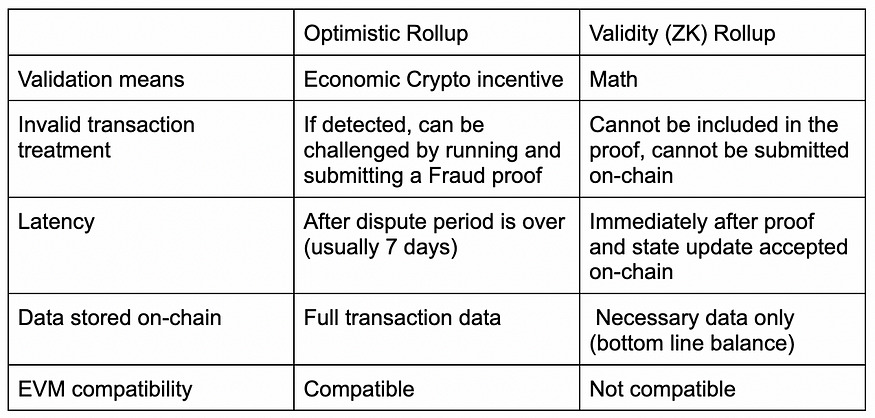Thriving bull markets cause L1 scalability issues to resurface.
There are three desirable properties that blockchains try to achieve: security, decentralization, and scalability. A well-known trilemma in the blockchain realm stipulates that only two of these properties can be achieved simultaneously within the same system, with a compromise on the third. In Ethereum, security and decentralization are prioritized over scalability.
As the number of people using Ethereum grows, a bottleneck of transactions is created, transaction speed slows down and gas prices rise. This cycle impedes Ethereum’s adoption at scale. Simply increasing the number of transactions per block would mean decreasing decentralization, because it would become more expensive for people to run Ethereum nodes (independent copies of the Ethereum transaction history). Additionally, very large block sizes could destabilize consensus, compromising security. To address these challenges, scaling solutions called rollups have emerged.
What Are Rollups?
Ethereum co-founder Vitalik Buterin has endorsed rollups as one of the most promising scaling solutions available. They work by moving transaction computations off-chain while storing transaction data on the Ethereum mainnet. This allows rollups to inherit Ethereum’s native security, which relies on Ethereum’s decentralization.
Here is how it works: thousands of transactions are being gathered into a batch. All transactions in the batch are being processed off-chain. The information from these transactions is then bundled into one transaction and is sent to be submitted on-chain.
Rollups are capable of producing significant gains in scalability because they move computation off-chain, while still submitting compressed data of the transactions to the Ethereum mainnet.
The Two Types of Rollups
Based on the method of rolling the computations off-chain, we get two types of rollups: Optimistic and Validity rollups.
Optimistic Rollups
Optimistic rollups operate under the assumption that all transactions in a batch are valid and therefore do not perform any computation by default. Once transactions are executed off-chain, the rollup posts a batch (containing transaction data) to Ethereum.
Invalid transaction: There is a challenge period (usually one week long), within which anyone can challenge a transaction. Challenging a transaction can be done by generating a fraud proof. Successful fraud proofs trigger a re-execution of the disputed transaction and update the rollup’s state accordingly.
Validity via economic incentives: The sequencer responsible for the erroneous transaction is penalized, and the protocol is thus secured by crypto-economic incentives.
Latency: If no transaction is disputed, once the challenge period is over, the data in the batch is deemed valid. While it is possible to continue building on an unconfirmed rollup block, there’s a risk of transactions getting reversed if they are based on an invalid transaction published previously.
Posting data on-chain: the data posted on chain contains the full data of the transaction
EVM compatibility: Optimistic rollups are fully compatible with Ethereum Virtual Machine (EVM). This enables them to use native Ethereum tools to build on top of optimistic rollups.
Additionally, transactions on optimistic rollups are fast because of the lack of computation involved. The finality of transactions on Ethereum, on the other hand, is slow, due to the challenge period during which transactions can be disputed. For example, users must wait for the challenge period to end before withdrawing their funds.
Validity Rollups
Also known as zero-knowledge rollups, Validity rollups bundle transactions into batches and process them off-chain. Then, the off-chain prover creates a validity proof for the validity of the transactions in the batch. The validity proof is a cryptographic assurance that the state change proposed by the rollup is indeed the result of executing a certain batch of transactions. After the off-chain process is completed, the system continues to the on-chain process: Rollup operators post a summary of the changes describing all the transactions in the batch, along with the validity proof. Validity proofs are very easy to verify, and this verification is done on-chain.
Validity via math: While optimistic rollups assume that the transactions are valid by default and verify them only if challenged, validity rollups use mathematical proofs to automatically ensure the integrity of transactions and secure the protocol. This allows for fast finality. For example, there are no delays in withdrawals from a validity rollup, because exit transactions are executed once the validity proof is verified.
Posting data on chain: Vailidty proof guarantees that all transactions in the batch are valid, and saves the need to review the whole information of all transactions. This allows an economical benefit which is that the state update that is sent to be submitted on-chain contains only the final balance that is the result of all transactions.
Evm compatibility: ZK rollups are not EVM-compatible by default, although with Warp and Kakarot, there are compilers for validity rollups on Starknet. Additionally, producing a validity proof, even though being done off-chain where computation is cheap, necessitates a significant amount of computational effort and time.
Another point of critique for some zero-knowledge rollups is the use of SNARK proofs, which require trust assumptions and make use of elliptic curve cryptography, which is not secure from attacks by quantum computers.
StarkWare’s Starknet and StarkEx are validity rollups that use STARKs instead of SNARKs, and this design choice comes with many advantages. STARKs do not require a trusted setup, are secure against quantum computers, and also offer more scalability than SNARKs.

The use cases for rollups on Ethereum
- Rollups provide higher throughput compared to a monolithic blockchain, unless the monolithic blockchain is centralized, which is not the case for Ethereum. The increase in transactions per second significantly enhances the user experience.
- All validity rollups settling on Ethereum will ultimately become seamlessly and atomically composable, which improves the composability of Ethereum.
- Rollups inherit their security from the settlement layer, making them almost as secure as Ethereum itself.
- Rollups are fully general-purpose, and one can even run an EVM inside a rollup, such as Kakarot on Starknet. This feature allows existing Ethereum applications to migrate to rollups with minimal need for writing new code. Additionally, transpilers like Warp simplify the process of deploying Ethereum’s Solidity smart contracts on Starknet.
Summary
As Ethereum tries to prioritize security and decentralization, scalability issues arise when the number of users increases. Rollups are the most promising solution to address these challenges, as they enhance scalability, without compromising Ethereum’s security and decentralization.



